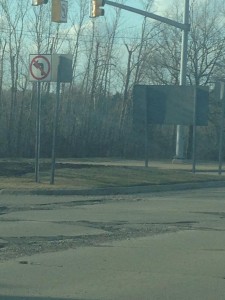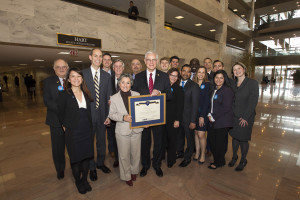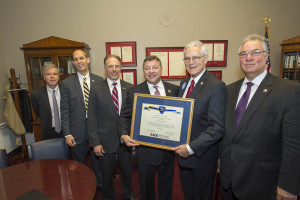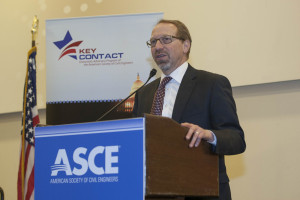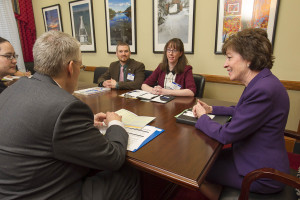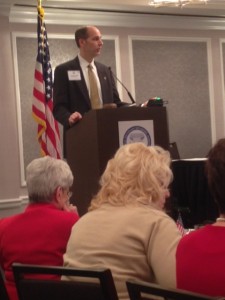Author Archive
We're Telling You First — the Save America's Infrastructure App Is Here!
May 11th, 2015 | By: Becky Moylan
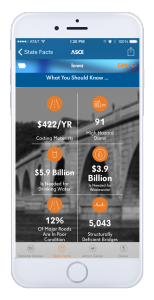 While around these parts it’s infrastructure 24/7/365, national Infrastructure Week now in its third year is a great opportunity to highlight the importance of infrastructure to the economy and the great strides being made to prioritize investment and renewal into our roads, bridges, ports, water pipes and other infrastructure.
As part of Infrastructure Week, today ASCE is releasing a new phone app. Help save America’s roads, water pipes, airports, and more by telling your elected officials to get to work on raising America’s infrastructure grades. Whether it’s an issue in your state or nationally, the new app will remind you when it’s critical for your elected leaders to hear from you.
Enter your zip code to find out how many structurally deficient bridges there are in your county and how your state compares to the nation overall. The app for iPhone and Android includes infographics, videos, national and state data, and news. It then enables you to take all that information and do something about it in the Action Center. Through the app you can contact your elected leaders with just a few taps and let them know that you expect their leadership in making infrastructure renewal a priority.
Our nation’s infrastructure most recently received a “D+” in the Report Card for America’s Infrastructure. This app gives you the opportunity to share the stats of our aging infrastructure with your social networks and elected leaders, to help increase awareness of these often “out of sight, out of mind” issues.
So download the new app right now for your iPhone or Android phone and join in (or continue) the effort to save America’s infrastructure as a way to celebrate Infrastructure Week from anywhere.
While around these parts it’s infrastructure 24/7/365, national Infrastructure Week now in its third year is a great opportunity to highlight the importance of infrastructure to the economy and the great strides being made to prioritize investment and renewal into our roads, bridges, ports, water pipes and other infrastructure.
As part of Infrastructure Week, today ASCE is releasing a new phone app. Help save America’s roads, water pipes, airports, and more by telling your elected officials to get to work on raising America’s infrastructure grades. Whether it’s an issue in your state or nationally, the new app will remind you when it’s critical for your elected leaders to hear from you.
Enter your zip code to find out how many structurally deficient bridges there are in your county and how your state compares to the nation overall. The app for iPhone and Android includes infographics, videos, national and state data, and news. It then enables you to take all that information and do something about it in the Action Center. Through the app you can contact your elected leaders with just a few taps and let them know that you expect their leadership in making infrastructure renewal a priority.
Our nation’s infrastructure most recently received a “D+” in the Report Card for America’s Infrastructure. This app gives you the opportunity to share the stats of our aging infrastructure with your social networks and elected leaders, to help increase awareness of these often “out of sight, out of mind” issues.
So download the new app right now for your iPhone or Android phone and join in (or continue) the effort to save America’s infrastructure as a way to celebrate Infrastructure Week from anywhere.
Tags: Infrastructure Week, phone app, Report Card for America's Infrastructure
2 Comments »
Happy Infrastructure Week
May 10th, 2015 | By: Becky Moylan
 Infrastructure Week is finally upon us. To kick off the week, Vice President Joe Biden and Secretary of Transportation Anthony Foxx are discussing the economic impact of our country’s deteriorating infrastructure systems at “America on the Move: Investing in America’s Economy” the morning of Monday, May 11 at 9:15 ET. Tune in to the webcast to hear the conversation.
In addition to Monday’s kickoff event, there’s a slew of things happening around the country. Here are a few sponsored by ASCE:
Infrastructure Week is finally upon us. To kick off the week, Vice President Joe Biden and Secretary of Transportation Anthony Foxx are discussing the economic impact of our country’s deteriorating infrastructure systems at “America on the Move: Investing in America’s Economy” the morning of Monday, May 11 at 9:15 ET. Tune in to the webcast to hear the conversation.
In addition to Monday’s kickoff event, there’s a slew of things happening around the country. Here are a few sponsored by ASCE:
- Congressional Briefing: Investing in America’s Flood Infrastructure, Monday, May 11 at 3:30 p.m. Rayburn House Office Building B-318, Washington DC
- 2015 Report Card for Arizona’s Infrastructure release, Wednesday, May 13 at 11:30, 2000 Rio Salado Parkway, Tempe, AZ 85281
- Pittsburgh on the Move, Wednesday, May 13 at 3 p.m., Carnegie Mellon University, Porter Hall Room 100
- Alaska Municipal Light & Power’s Most Energy Efficient Plant: A Look Behind the Construction Fence at Alaska’s Resilient and Sustainable Energy Infrastructure Wednesday, May 13 at 10 a.m., Juneau, AK
- Infrastructure Delivers More Than You Think: Tour Port NoLa, Thursday, May 14 at 9 a.m, 1350 Port of New Orleans Place New Orleans, LA
Flat Funding is Flat Outrageous
May 7th, 2015 | By: Becky Moylan
As the deadline to reauthorize the federal surface transportation bill nears, the measure of success for many involved seems to be maintaining the status quo. Last week, leaders in the U.S. House of Representatives began touting “flat funding” as an accomplishment that Congress must work to achieve. But it’s flat out not. Here are some of the things that will happen if Congress simply continues the status quo over the next few years, from ASCE’s economic study on transportation:- It will cost each American family’s budget $1,060 every year through at least 2020
- America will lose more than 876,000 jobs by 2020
- 234,000 jobs will force workers to take paycuts in 2020
- S. exports will drop by $28 billion in total by 2020
- America’s GDP will underperform by $897 billion in total by 2020
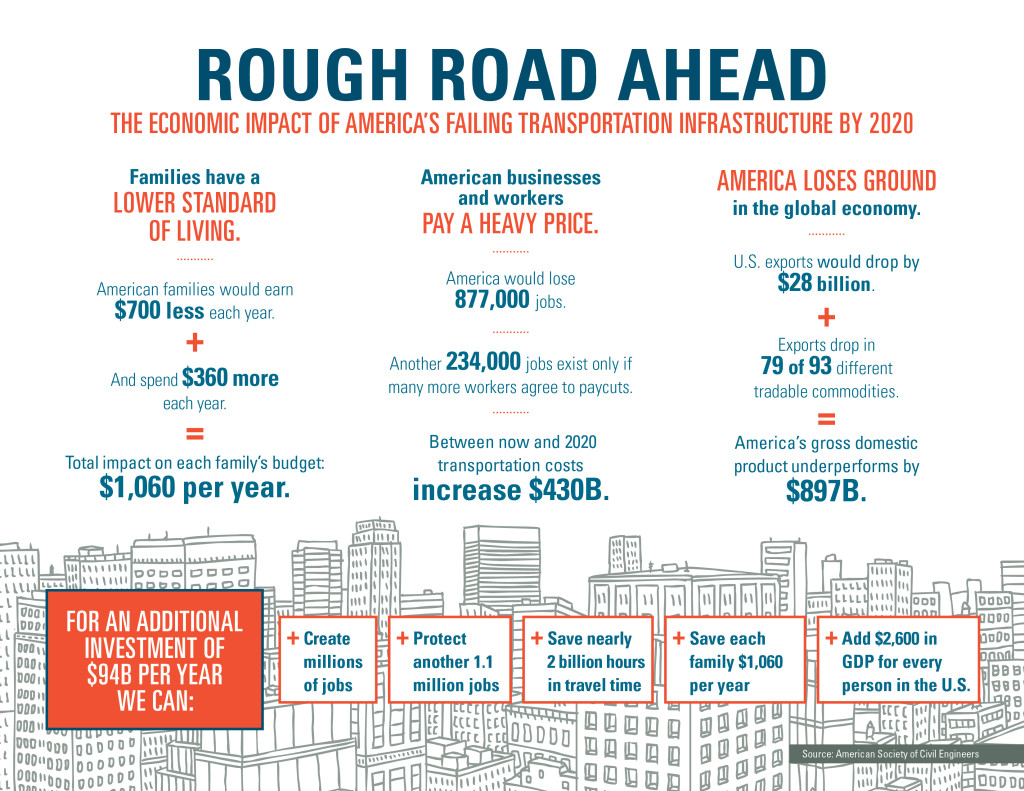 A multiyear bill that continues the same amount of funding we’ve had since 2005 through SAFETEA-Lu is the opposite of aspiration. It will not help improve our low Report Card grades for surface transportation, and will do little to strengthen the economy. However, there is a way to not only fill the funding hole of the Highway Trust Fund but also grow the system. By increasing the federal gas tax, we can start investing in the projects America needs to have in place in order to continue to compete globally in the21st century. Every state has dozens of new construction projects that they would like to make a reality if they only had increased investment from all levels of government. Here’s our chance.
To fill the current federal funding gap and grow the federal Highway Trust Fund to address current documented needs, Congress should raise the gas tax by at least 20 cents. This would be the first increase since 1993, and the bump would recoup what has been lost due to inflation and increase funding. For the average driver, it will cost about $187 more a year*. In contrast, right now each motorist is paying $324 a year in additional repairs and operating costs. In addition, Americans spend an average 34 hours a year stuck in traffic, costing the U.S. economy $101 billion in wasted fuel and lost time annually. It’s a savings for your wallet by staying out of the auto mechanic shop. It’s an even bigger savings as it protects that $1,060 mentioned above.
There is a lot at stake if we merely continue with the same level of funding of the past 10 years for the next five. It will hurt your personal finances, hurt our already aging transportation system and do little to benefit our economy. Let’s increase our investment so that Congress truly fixes the Trust Fund in a way that allows us to modernize our transportation system.
Join ASCE in telling your Senators and Representative that you expect their leadership in passing a long-term, sustainable fix to the Highway Trust Fund that includes an increased investment to modernize the transportation system.
*calculated based on 18 gallon tank x 20 cents x 52 fill-ups a year (once a week)
A multiyear bill that continues the same amount of funding we’ve had since 2005 through SAFETEA-Lu is the opposite of aspiration. It will not help improve our low Report Card grades for surface transportation, and will do little to strengthen the economy. However, there is a way to not only fill the funding hole of the Highway Trust Fund but also grow the system. By increasing the federal gas tax, we can start investing in the projects America needs to have in place in order to continue to compete globally in the21st century. Every state has dozens of new construction projects that they would like to make a reality if they only had increased investment from all levels of government. Here’s our chance.
To fill the current federal funding gap and grow the federal Highway Trust Fund to address current documented needs, Congress should raise the gas tax by at least 20 cents. This would be the first increase since 1993, and the bump would recoup what has been lost due to inflation and increase funding. For the average driver, it will cost about $187 more a year*. In contrast, right now each motorist is paying $324 a year in additional repairs and operating costs. In addition, Americans spend an average 34 hours a year stuck in traffic, costing the U.S. economy $101 billion in wasted fuel and lost time annually. It’s a savings for your wallet by staying out of the auto mechanic shop. It’s an even bigger savings as it protects that $1,060 mentioned above.
There is a lot at stake if we merely continue with the same level of funding of the past 10 years for the next five. It will hurt your personal finances, hurt our already aging transportation system and do little to benefit our economy. Let’s increase our investment so that Congress truly fixes the Trust Fund in a way that allows us to modernize our transportation system.
Join ASCE in telling your Senators and Representative that you expect their leadership in passing a long-term, sustainable fix to the Highway Trust Fund that includes an increased investment to modernize the transportation system.
*calculated based on 18 gallon tank x 20 cents x 52 fill-ups a year (once a week)
Tags: gas tax, highway trust fund, surface transportation
No Comments »
Majority of Americans Say Yes to Gas Tax Increase to Fund Transportation
April 30th, 2015 | By: Becky Moylan
In the debate on how to best fix the Highway Trust Fund, often times lawmakers shy away from the most direct funding source: a raise to the federal gas tax. Its last increase was in 1993, and since that time it has lost a third of its purchasing power. While many states have taken bipartisan action in the past few years to better fund their roads, bridges, and transit using this method, federal lawmakers have continued to be reluctant as previous research has indicated opposition to an increase. However, a new research poll shows that a majority of voters would support an increase to the gas tax, so long as it goes toward better transportation infrastructure. The study, released by the Mineta Transportation Institute, found 69 percent of respondents willing to pay a 10-cent per gallon increase for improved road maintenance. In addition to supporting an increased investment in roads and bridges, two-thirds of respondents also agreed that some gas tax revenues should go toward transit, as most people want good public transit service in their state. As Congress must act by May 31 to reauthorize the surface transportation law, this new study demonstrates that voters support finding the needed funding through an increase to the gas tax. While the 10-cent increase tested in this research would not grow our system in the future, it can act as a springboard to improve America’s roads, bridges, and transit. The bottom line: Americans want better transportation and they are willing to pay for it.Tags: bridges, gas tax, highway trust fund, public transit, roads
1 Comment »
Education Bill on the Move
April 21st, 2015 | By: Becky Moylan
Exposing students to a science, technology, engineering, and math (STEM) curriculum is an essential part of making sure we are prepared for our future infrastructure needs, as it ensures that the next generation has civil engineers who can continue to be stewards of our nation’s infrastructure. Currently, the U.S. Congress is considering an education bill that would play a role in defining the STEM curriculum. The Senate Health, Education, Labor and Pensions (HELP) Committee last week approved, by an unexpected unanimous vote, the Every Child Achieves Act. The bill was a compromise worked out between Committee Chairman Lamar Alexander (R-TN) and Ranking Democrat Patty Murray (D-WA) and would reauthorize and amend the Elementary and Secondary Education Act (ESEA), replacing the previous version best known as “No Child Left Behind.” NCLB has proven to be controversial and since 2006 efforts by Congress to move to the next reauthorization have failed. The approval last week by the HELP Committee is the first positive move in some time. As approved the bill would continue to require the current level of testing in reading, math, and science, but it would allow states to set up their own accountability systems. Essentially the law continues to measure the academic progress of students, but restore to states the responsibility for deciding what to do about improving student achievement. The compromise nature of the measure means that few policy stakeholder groups are fully satisfied with the bill in its current form. Consideration by the full Senate, which hasn’t yet been scheduled, is likely to spark some partisan fireworks over issues ranging from school vouchers to the level of the power the U.S. Department of Education should have when it comes to ensuring schools are improved for disadvantaged students. To foster an appreciation and understanding of Stem at the K-12 level, one of ASCE’s 2015 Federal Priority Issues, based on a survey of members and adopted by the Board of Direction, is STEM education. Toward that end, ASCE is a member of the STEM Education Coalition, a Coalition which is comprised of more than 500 business, professional and education organizations, with the goal of improving U.S. achievement in STEM subjects. Since ESEA is the single largest federal legislation dealing with K-12 education, it is the Coalition goal to make sure that any reauthorization makes STEM education a priority. ASCE and its allies in the STEM Coalition score a victory during the bill’s consideration when a Coalition-endorsed amendment sponsored by Senators Al Franken (D-MN), Mark Kirk (R-IL) was adopted by a 12-10 vote. The amendment provides each state with formula-based funding to support partnerships between local schools, businesses, universities, and non-profit organizations to improve student learning in STEM subjects. Each state would choose how to spend and prioritize these funds, which can support a wide range of STEM activities from in-depth teacher training, to engineering design competitions, to improving the diversity of the STEM workforce. As mentioned above, the legislation faces hurdles ahead. Providing the measure can gain full Senate approval, there is still the matter of the House of Representatives. The House Education and Workforce Committee approved their version of ESEA reauthorization, H.R. 5, the Student Success Act on a strictly partisan vote. However, on the House floor, the bill stalled after conservative groups objected that the bill did not go far enough to cut programs and pull back federal involvement in education. Provided the full Senate can approve its version of the reauthorization, it is clear that the only way forward is for the House Republican leadership to accept Democratic support in order to move the bill to the White House.Tags: stem
No Comments »
Michigan Must Say Yes to Safer Roads
April 8th, 2015 | By: Becky Moylan
In Michigan, a common saying is “there are two seasons: winter and road construction.” Rough winters and underinvestment for the past 50 years have led the Great Lakes state to have some of the worst roads in the nation. And while construction season may seem constant during the warmer months, the truth is currently the state cannot keep up with meeting the needs to maintain or improve roads and bridges. The continual underinvestment has led to a backlog of needs and safety issues. Gov. Rick Snyder has been advocating for the past few years that something needs to be done to change the state’s trajectory. Last December, in an eleventh hour deal, the state legislature decided to punt the decision to the voters. In just under a month, the option to increase funding for roads will be considered at the polls. If passed, Proposal 1 would raise $1.2 billion a year to be invested exclusively into transportation. As I drove around my hometown last week, this seemed like a no-brainer. I’ve included a couple photos, but it does not fully do the problem justice. Many roads are in such bad shape that debris lines the shoulders of the street, rubble that is a byproduct of the potholes and gaping cracks in the pavement. The same month state lawmakers devised Prop 1, TRIP released a study revealing poor roads were costing the average Michigan driver $539 a year —and remember it’s the Motor City, people love their cars and many work for the auto industry. In some areas the extra vehicle operation costs that include accelerated vehicle depreciation, additional repairs, increased fuel consumption and tire wear costs drivers as much as $851 a year. Here is how Proposal 1 works:- Raise the state sales tax rate by one penny, from 6 percent to 7 percent
- Implement a series of laws that exempt fuel from the sales tax, then impose a higher fuel tax whose revenue would be used exclusively for transportation
- Raise vehicle registration fees to increase transportation funding
- Raises $1.2 billion each year to increase investment in transportation—bringing Michigan more in line with the transportation investment of neighboring states
- Ensure every penny raised at the gas pump goes to improving Michigan’s roads, bridges and public transit
- Protect taxpayers by getting road builders to give warranties on the roads they build
Tags: bridges, Michigan, roads, surface transportation, transit
2 Comments »
ASCE Recognizes Lawmakers' Infrastructure Leadership
April 2nd, 2015 | By: Becky Moylan
To successfully save America’s infrastructure, the U.S. needs strong leaders dedicated to investing in our roads, bridges, water pipes, levees and other infrastructure. Two such lawmakers who exhibit bold leadership and resolve to improve our nation’s infrastructure are Sen. Barbara Boxer (D-CA) and Congressman Bill Shuster (R-PA). In recognition of both lawmakers’ efforts to prioritize infrastructure, the American Society of Civil Engineers inducted Sen. Boxer and Rep. Shuster as Honorary Fellows. A rare distinction, only 38 individuals have been bestowed this honor, including these most recent inductees. Sen. Boxer distinguished herself as a champion for infrastructure over the course of her more than 30 years of public service, which includes 24 in the U.S. Senate. As Chairwoman of the Environment and Public Works Committee, she led the effort to enact the Water Resources Reform and Development Act (WRRDA) and the Moving Ahead for Progress in the 21st Century Act (MAP-21). Similarly, Rep. Bill Shuster earned this recognition for his efforts as an eight-term member of the House of Representatives. As Chairman of the Transportation & Infrastructure Committee, he helped shepherd the passage of MAP-21 and steered the effort to enact WRRDA. Both honorees were recognized by ASCE last week during the 15th annual Legislative Fly-In. Both Congressman Shuster and Sen. Boxer exemplify the type of leadership we need to successfully improve our nation’s “D+” infrastructure. Thanks to their leadership and vision, Congress has started to address the backlog of investment needs. Both lawmakers will continue to play an important role in future infrastructure legislation, starting with the need to find a long-term, sustainable solution to fix the Highway Trust Fund.ASCE Members Meet With US Lawmakers
March 30th, 2015 | By: Becky Moylan
“Let’s win this for our country,” proclaimed ASCE President Robert D. Stevens, PhD, PE to a room of nearly 200 ASCE members who descended on the nation’s capital to encourage members of Congress to fix the Highway Trust Fund last week. The group visited Washington, D.C. as part of the 15th annual ASCE Legislative Fly-In, which offers the opportunity for ASCE members to engage with their elected representatives and senators about the policy issues that impact civil engineers. The two-day event included briefings on federal legislative issues, including the Water Resources Reform and Development Act (WRRDA) appropriation process and the need for Congress to pass a long-term transportation bill this year. To further the conversation on transportation, attendees were addressed by the U.S. Department of Transportation Under Secretary for Policy, Peter Rogoff on Tuesday evening and Congressman Earl Blumenauer (D-OR) on Wednesday morning. Rogoff thanked the group for making the journey to Washington to highlight this important issue, remarking “No one is closer to infrastructure than you and your colleagues.” He then outlined the reasons America needs a bolder plan for the future to meet the demands of a growing population. Despite the major maintenance needs in addition to needs to account for future growth, the transportation network is, as Rogoff put it, “starved for funds.” Rogoff warned that with 32 short-term extensions, local and state leaders tend to stop planning long-term projects, which can take many years of planning and building. “When you have 32 short term extensions people lose their vision. Why would you plan a project…if you don’t know the federal government will pay its bills eight months hence?” he asked rhetorically. This is why it is so important to fix the Highway Trust Fund in a way that increases funding: so that we can move beyond the status-quo, and start shaping the future of our transportation network. For example, Rogoff pointed to the Administration’s GROW AMERICA Act, which increases funding for public transit to ensure it can be upgraded to meeting growing demand. The administration is pushing hard for an increase in investment, because they believe that given the political challenges facing this legislation at the end of it there should at least be positives to show for it. “It is no victory to maintain current levels of spending,” said Rogoff. Ultimately, Rogoff had cautious optimism that there could be a multi-year bill passed this year. “Mayors and governors are starting to sound off this is no way to run this program. You can say it with even more credibility,” he concluded. Congressman Blumenauer (D-OR) shared an equally compelling message. The $3.6 trillion investment need estimated by ASCE is “within our capacity and … will repay for itself” he said, adding that it would bring down the deficit in the long term. Blumenauer highlighted many benefits that would result from increasing investment in transportation, including reducing time wasted sitting in traffic, enhancing quality of life for every family, and creating jobs in a range of opportunities. The Congressman earlier this year proposed the UPDATE Act, HR 680, which would raise the rate of the gas tax by five cents for the next three years then tie it to inflation to address the funding deficit in the Highway Trust Fund. When he introduced the bill, he had 20 co-sponsors and endorsements from many organizations, including ASCE. He acknowledged that many of his colleagues are wary of repercussions from voting for a tax increase. To help them find the political courage, Blumenauer told the Fly-In attendees to reassure them that there is sufficient political cover. “Ninety-eight percent of the legislators that voted to increase the gas tax [on the state level] got re-elected in 2014. Make it clear that what ends the career is allowing the country to fall apart if they can’t meet the needs of your community,” said Blumenauer. As further evidence of the historically bipartisan nature of infrastructure investment, Blumenuaer recounted when President Reagan called on Congress to more than double the gas tax in his 1982 Thanksgiving address. Congress responded by doing so when they returned to Washington after the holiday. In conclusion, Blumenauer shared that he counts on ASCE for continued support on this issue and to help get a bill passed: “I hope we’ll be at a signing ceremony in the future for a six-year re-authorization.” The 200 ASCE members in attendance then headed to Capitol Hill to meet with members of Congress and their staffs of 46 states and the District of Columbia. Following the meetings, the group reconvened at a reception in the U.S. Capitol Cannon Caucus Room featuring a Dream Big!: Engineering Wonders of the World theme in anticipation of the ASCE-sponsored IMAX film coming out next year. ASCE members and Congressional staffers were able to continue their conversations from the afternoon while networking and having some fun taking photos in front of a green screen photo booth, which then transformed the background into iconic infrastructure backdrops. During the proceedings, Sen. Barbara Boxer (D-CA) and Rep. Bill Shuster (R-PA) were both presented with awards naming them Honorary Fellows of the Society. Sen. Boxer was selected in honor of her more than 30 years of public service, which includes 24 in the U.S. Senate. As Chairwoman of the Environmental and Public Works Committee, she led the effort to enact the Water Resources Reform and Development Act (WRRDA) and the Moving Ahead for Progress in the 21st Century Act (MAP-21). Rep. Bill Shuster earned ASCE’s recognition for his efforts as an eight-term member of the House of Representatives. As Chairman of the Transportation & Infrastructure Committee, he helped shepherd the passage of MAP-21 and steered the effort to enact WRRDA. Including last week’s inductees, there have only been 38 Honorary Fellows named by the Society. Also recognized during the Fly-In were the winners of the inaugural Outstanding Civil Engineer Advocate of the Year awards, recognizing an individual and group who went above and beyond in advocating for ASCE’s issues in the past year. This year’s winners were Darren Benoit of New Hampshire and the Louisiana Section. The two days encapsulated the resolve the American Society of Civil Engineers has to encourage Congress to fix the Highway Trust Fund with a long-term, sustainable solution. To contribute in this effort, sign up to be a Key Contact today.Tags: advocacy, fly-in, highway trust fund
Comments Closed
States Stepping Up
March 24th, 2015 | By: Becky Moylan
A growing number of states are taking action during their legislative sessions to increase investment in transportation. This trend is in vogue for several reasons. First, many states that have taken action have done so after years of kicking the can down the road. For example, Iowa’s 10-cent increase is the first boost since 1989. In that time, the cost of most other goods has nearly doubled. Yet, Iowa was trying to fund 2015 roads and bridges on 1989 dollars. That underinvestment was costing the state’s economy in other ways, as a recent assessment by TRIP demonstrated. Iowa’s roads and bridges are costing each Iowan $2 billion in additional vehicle operating costs, lost time and fuel due to traffic congestion, and financial costs from traffic accidents. Thanks to the increased revenues, the state will begin addressing many of its needs. Second, bipartisan action reflects the increasing understanding that deferring maintenance in the face of a funding deficit hurts economic competitiveness. Utah, another state that passed gas tax increase legislation this session, is expected to have huge population growth in the coming decades. To meet future needs, as well as address a projected funding shortfall, that state needed to increase its investment. Investing in roads and bridges has historically been a place of agreement from both sides of the aisle, and that trend continues this year. Another reason we have seen action is that people are sick of potholes and sitting in traffic and are becoming increasingly vocal about their desire to have safe, well-maintained roads and bridges. In the press release South Dakota Gov. Daugaard issued after signing his state’s gas tax increase into law, he emphasized that maintaining roads and bridges is one of the fundamental functions of government. The more lawmakers hear from constituents on the need for better roads and bridges and greater access to transit, the more likely they are to make it a legislative priority. Several other states are poised to take action this year that would better fund transportation. In legislative action, Idaho, Georgia and Washington are all considering and compromising on bills that would address each respective state’s needs. Also on the horizon are Minnesota, North Carolina and Nebraska. In Michigan, voters will head to the polls on May 5th to decide on a ballot measure that would increase funding for the Great Lakes state’s transportation network—a measure endorsed by many influential groups, the Governor, and the Detroit Free Press. All of this action at the state level, however, cannot take the place of the federal government’s essential role in transportation investment. To continue the momentum of this year’s state action—along with the trend of the past few years—the U.S. Congress needs to find a long-term, sustainable solution to fix the Highway Trust Fund. If they fail to act, our nation’s economic competitiveness is in jeopardy and states will be stuck with a much larger tab, or an even longer backlog of projects.Tags: congress, gas tax, highway trust fund, state government
No Comments »
Lt Governors Talk Infrastructure Investment
March 19th, 2015 | By: Becky Moylan
Infrastructure investment was a key topic on the agenda at the The National Lieutenant Governors Association (NLGA) annual Federal-State Relations meeting this week in Washington, DC. ASCE’s Executive Director Tom Smith participated in a panel discussion with Robert Atkinson from the Information Technology and Innovation Foundation to help Lt. Governors tackle this important issue. Lt. Governors from 18 states were in attendance this week to hear from policy leaders on a variety of issues, but clearly infrastructure is front and center on their priority list. The panel discussion, entitled “Infrastructure Investment Conversation: How soon and how?,” tackled a variety of possible policies that states are considering particularly to address transportation financing such as tolls, vehicle miles travelled fees, and of course increases in fuel taxes. NLGA has acknowledged that infrastructure is critical to the economy and that 21st century jobs require a 21st century infrastructure – from ports and roads to rail and aerospace. The state and territories second-in-command understand the potential consequences of delays or underinvestment in infrastructure improvement. The Lt. Governors spent their meeting time in Washington focusing on solutions they can take back home to address this important issue in their state.


 */ ?>
*/ ?>




